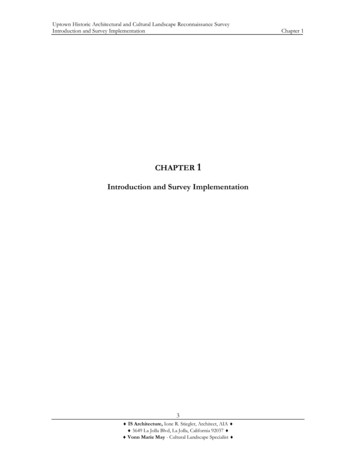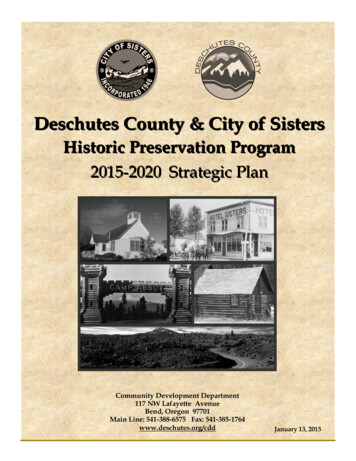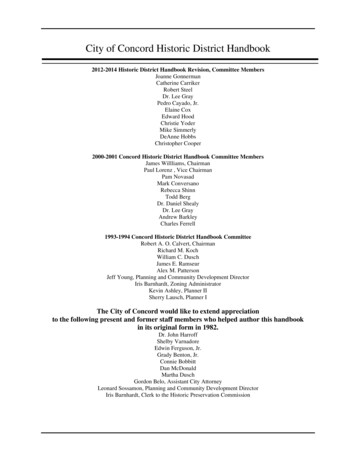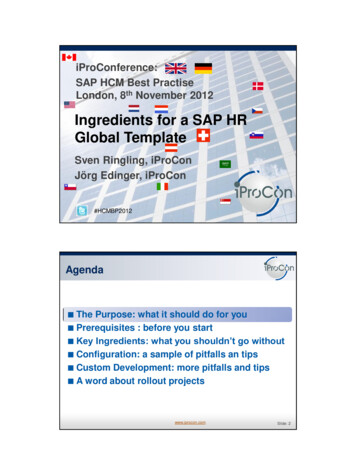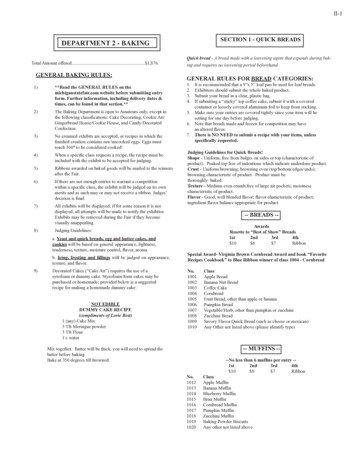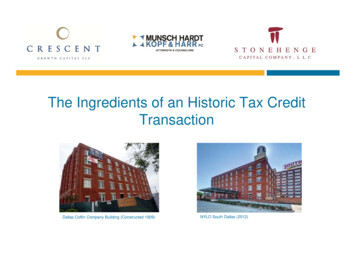
Transcription
The Ingredients of an Historic Tax CreditTransactionDallas Coffin Company Building (Constructed 1909)NYLO South Dallas (2012)
Agenda1. Historic Tax Credits: A Brief History2. Structuring Primer3 Parties to an HTC Transaction3.4. Economics: Cash Flow Waterfall5. Structuring Federal HTCs6 Key HTC Issues (Incl.6.(Incl Equity Markets)7. Structuring Texas HTCs8. The Parallel Track: The Eligibility Process9 Q&A Session9.Wilson Building, Dallas
Pressures on the historic builtenvironmentitAfter World War II, a tidal wave ofsuburbanization and urbanrenewal swept the nation,decimating the historic builtenvironment.The National Historic PreservationA t off 1966 was thActthe fifirstt policyliresponse. It established: National Register of Historic PlacesState Historic Preservation Offices(SHPOs)Section 106 ReviewPenn Station (1911)
Federal Financial Incentives forHi t i PreservationHistoricPtiTax Reform Act of 1976: Ended accelerated depreciation forstructures replacing demolishedhistoric buildingsEstablished deduction for QREsincurred rehabilitating historic buildingsRRevenueAActt off 1978:1978 Created the Federal HistoricRehabilitation Tax Credit(an Investment Tax Credit, at first equal to 10% ofQREs incurred)The Healing Center (2010 and 2012)
Federal Financial Incentives forHi t i PreservationHistoricPtiTax Reform Act of 1986: Established the current value of theFederal Historic Rehabilitation TaxCredit: 20% of QREs incurredInstituted passive activity loss limitsHousing and Economic Act of2008: Allowed filers to apply the HTC againstan AMT liabilityLiberalized tax-exemptp use rules1936-38 Magazine Street (2010 & 2012)
Financial Incentives for HistoricPreservation (State(SLevel))
Historic Tax Credits and Structuring The Federal Historic Rehabilitation Tax Credit is one of severalInvestment Tax Credits that may be earned by equity investors to aproject The credit is not “bought” or “sold” but is typically passed through to a tax credit investor via amaster lease The Texas State Historic Tax Credit is transferrable; it can bebought and sold. If sold, the seller incurs a federal income tax liability upon receipt of the sale proceedsIf allocated, tax is not owed, but the state tax credit investor must contribute equity to the project Numerous structuring challenges include: Subordination, Non-Disturbance and Attornment (“SNDA”) AgreementCash Flow Distributions to Investor-OwnerTax-exempt use rules (“disqualified lease”)Passive activity rulesRevenue Procedure 2014-12 Compliance (Historic Boardwalk Hall)Capital at-risk
Parties to an HTC Transaction Developer/Sponsor Tax Credit Arranger Acts as historic preservation consultant, securing eligibility for historic tax creditsModels the projectproject’ss financing to incorporate all funding sourcesCoordinates financial structuring and tax credit monetization Legal Team Advises on structureAuthors legal opinions needed by investors and lenders Tax Credit Investor/Buyer Provides tax credit equity at financial closing, during construction and at completionPurchases historic tax credits at project certification LendersL d
Economics – Cash Flow Waterfall toProjectProject SizeEligible Basis (QRE)Tax CreditsEquity PriceSales PriceGross Proceeds at CloseFederalHistoric TaxCreditsState HistoricTax Credits20 0%20.0%12,000,00010,000,0002 000 0002,000,00012,000,00010,000,0002 500 0002,500,00012,000,00010,000,0004 500 3,680,00080.0%EstimatedEid FeesF& ClosingCl i CostsCNet Proceeds at Close/CertificationEstimated Aggregate Annual DistributionsExit/Put PriceNet Benefit (Before Tax)Income Tax LiabilityAfter Tax Net Benefit25 )1,128,5003,280,000(721,500)2,558,500
Structuring Federal HTCs - Closing
Structuring Federal HTCs - Certification
Structuring Federal HTCs - Compliance
Structuring Federal HTCs - Exit
Key HTC Issues Intercreditor / Priority AgreementsSubordination, Non-Disturbance / Forbearance AgreementsBridging Requirements and Lender PriorityLoan / Equity Funding TimingCompliance Period and ExitTax consequences
Impact of Historic Boardwalk Hall:Summary of IRS Revenue Procedure 2014-12 Partnership Interest 99% interest in the Master Tenant flipping to 5% interest as of the Transition Date No minimum required return To the extent that the partnership is generating an economic return, then the investor must receive itsstated pro-rata percentage (99%) of such return, Income must be contingent (variable) upon partnership income, and not fixed in nature. Lease,Lease Fees & Other Arrangements Investor income can’t be diluted by any unreasonable fees, disproportionate distributions, leaseobligations Fees and lease obligations are okay if supportable in a non-HTC context Lawyers typically do not make such reasonableness assumptions, but will likely rely on third-partyvaluation divisions of accountingg firms for comparablepanalysis.y Guarantees Impermissible Guarantees: Ability to claim the credits, Transaction Structure, Distributions Permissible Guarantees: CoCompletion,p e o , OpeOperatinga g Deficit,e c , Environmental,o e a , Actscsoor OOmissionsss o s Exit No Calls Puts at lower of fixed price of FMV
Accessing the HTC Equity Market:Factors forf CCompetitive Projects Scale Large investors are looking for 3MM in tax credits (i.e., 15MM in QREs) Large investors include certain large corporations, banks and several equity funds Small Deal Funds will evaluate any deal size, but pricing is lower Community and Regional Banks are sometimes active tax credit investors and, where available, canprovide competitive terms relative to Small Deal Funds Developer experience Having a team (developer, architect, general contractor, tax credit arranger, attorneys, accountants, etc.)in place that has historic rehabilitation experience helps sell a deal to the investor community Bridging & Bank Loans Bridge loans are often used fund project expenditures prior to receipt of the full amount of tax creditequity proceeds Banks providing senior debt alongside of an HTC investment need to be comfortable with restrictions ontheir remedies in a foreclosure Historic Boardwalk Hall Put many investors on the sidelines pending additional guidance from the IRS Rev-Proc 2014-12 issued in January 2014 provided Safe Harbor procedures Purpose of the Safe Harbor was to bring investors back into the market – which appears to be happening
Texas Historic Rehabilitation Tax CreditSubchapter S of Chapter 171171, Tax CodeBenefit: 25% of QREs credit against Texas Franchise Tax with no cap, 5 yearcarry-forward Bifurcated: Can be sold, transferred, assigned, or allocated withoutli i ilimitation;subjectbjto registrationii withihCComptrollerll No recapture period Credit is available during tax year when project is placed in serviceEligible Buildings – Same as FHTC and includes (a) Recorded TexasHistoric Landmark under Section 442.006 and ((b)) State archeologicalglandmark under Chapter 191Effective Date: January 1, 2015 but QREs incurred up to 5 years priorcan be included in an applicationRegulations: Tex. Admin. Code Title 13, Part II, Chp. 13Texas Capitol Building,Building Austin,Austin TXLEGISLATIVE UPDATE: HB3230 - Permits tax-exempt entities to incur"eligible costs and expenses" . Passed House and Senate; pendingGovernor approval
Texas SHTCs - Investor PerspectiveCHARACTERISTICS OF INVESTMENT CANDIDATES Property type - Multi-family, mixed use, special use, hospitality, office, retail Developer has site control of property Construction and permanent debt has been identified NPS Part I completed; Part II submitted ExperiencedpHTC architect and contractorINVESTMENT PREFERENCES Development cost 1 million Development period than 24 months Qualified Rehabilitation Expenditures (QREs) 2 million Catalyze further redevelopmentPRICING SHTCS Very competitive market for Texas SHTCs and pricing can range from .83 to .88 per credit (net to projectafter federal income tax of .60 to .70 per credit, depending on tax rate) Credits are most in demand when Franchise Taxes are due to the ComptrollerBRIDGE FINANCING Bridge financing for Texas SHTCs is available but can be difficult to structure and pricing varies project toproject
Structuring Texas SHTCsDirect Sale - Project Owner sells the certificated tax credits to athird party purchaser. The sale proceeds are consideredinvestment income subject to capital gains taxes under theInternal Revenue Code to the Project Owner.Allocation – Project Owner allocates the Texas SHTCs inaccordance with capital accounts and each partner utilizes theTexas SHTC or sells them. Allocation is not subject to federalincome tax but subsequent sale would be subject to capitalgains tax to seller.Minimizing Capital Gains – Project Owner or allocatee holdsTexas SHTCs for a minimum of 13 months to have any gaintreated as a long-term capital gain.1700 Commerce, Dallas Texas
Structuring Texas SHTCsLLossPPartnertMModeld l (Mi(Missouri)i) Corporation with large loss carry-forwardadmitted as limited partnerLoss Partner is specially allocated SHTCsLoss Partner sells the SHTCs to SHTCInvestorNet Effect: Loss Partner recognizes incomefrom the sale of the SHTCs but does not paytax because of loss carry-forwardsConcern: Use of a corporation for "taxavoidance purpose"; disproportionateallocation may suggest Loss Partner is not a"partner"ProjectOwnerTax Credit EquitySpecial Allocationof SHTCs & SHTC IncomeLossPartner (1%)SaleProceedsSale ofSHTCsSHTC Investor
Structuring Texas SHTCsN P fit ModelNon-ProfitM d l (M(Massachusetts)htt ) SHTC is allocated to GPGP donates SHTCs to unrelated Non-ProfitNon Profit sells SHTCs to SHTC InvestorNon-ProfitCharity loans proceeds of sale to ProjectOwnerNet Effect: Income realized by tax-exemptorganizationConcern: quid pro quo; unrelated businesstaxable income for charity; project ownerhas debt that if forgiven would beconsidered "cancellation of debt" incomeSHTCInvestorProjectOwnerSpecial Allocationof SHTCsGeneralPartner (10%)Sale Loan ofSHTCProceeds
Eligibility for Historic Tax CreditsCertified HistoricStructure (CHS) CHS status must be secured topermit pursuit of historic taxcredits Building in question can befound to be a “contributingelement” to an historic district Building can be individuallylisted on the National Registerof Historic Places
Eligibility for Historic Tax CreditsHistoric PreservationCertification Application(HPCA)Nomination to NationalRegister of Historic Places(NR) Part 1/Part A – Evaluation ofSignificance Part 2/Part B – Description ofRehabilitation Part 3/Part C – Request forCertification of Completed Work Determine viable listingcriterionWrite nominationNomination reviewed by statelevel committeeNomination approved byNational Park Service
Eligibility for Historic Tax CreditsPart 2/Part B – Description ofRehabilitation Historic Tax Credit Arranger authorsapplication working with THC/NPSapplication,and Project Architect to craft asubmission in conformance with theSecretary of the Interior’s Standardsfor RehabilitationPart 3/Part C – Request forCertification of Completed Work Historic Tax Credit Arrangerdocuments completed work andsubmits Part 3 for THC and NPSreview.iCCostt certificationtifi ti reporttcertifies the final total of QREs, theamount claimed in the Part 3/Part Csubmission
Existing Floor Plans – Bldg 16
Proposed Floor Plans – Bldg 16
CHS Status for the Buildings
PresentersPhillip ("Phill") J.F. GehebEmail: pgeheb@munsch.comPhone: 214.855.7560Whitney LaNasaEmail: wllanasa@stonehengecapital.comPhone: 225.408.3265Frank RabalaisEmail: frank.rabalais@cgcapllc.comPhone: 504.378.3471Troy VillafarraEmail: troy.villafarra@cgcapllc.comPhone: 504.378.3472
Texas SHTC or sells them. Allocation is not subject to federal income tax but subsequent sale would be subject to capital gains tax to seller. Minimizing Capital Gains - Project Owner or allocatee holds Texas SHTCs for a minimum of 13 months to have any gain treated as a long-term capital gain. 1700 Commerce, Dallas Texas




